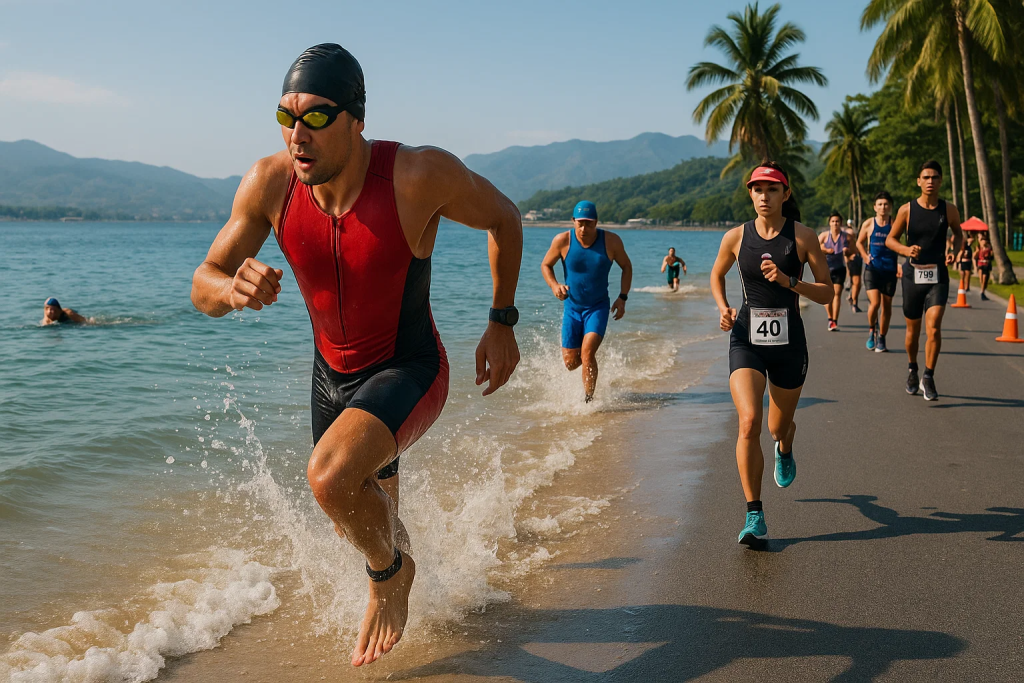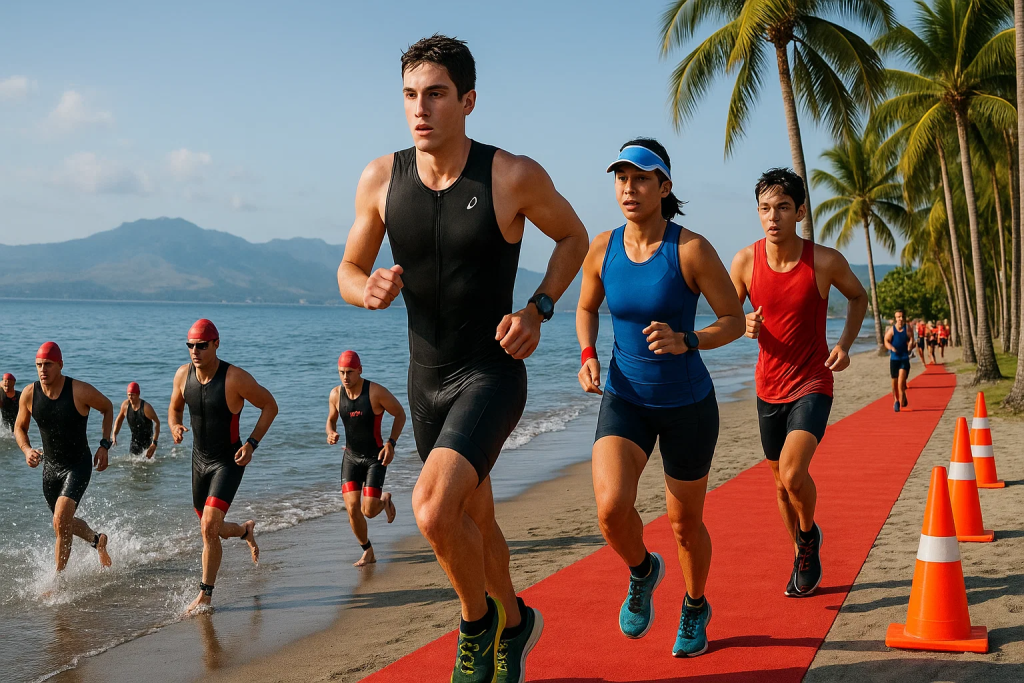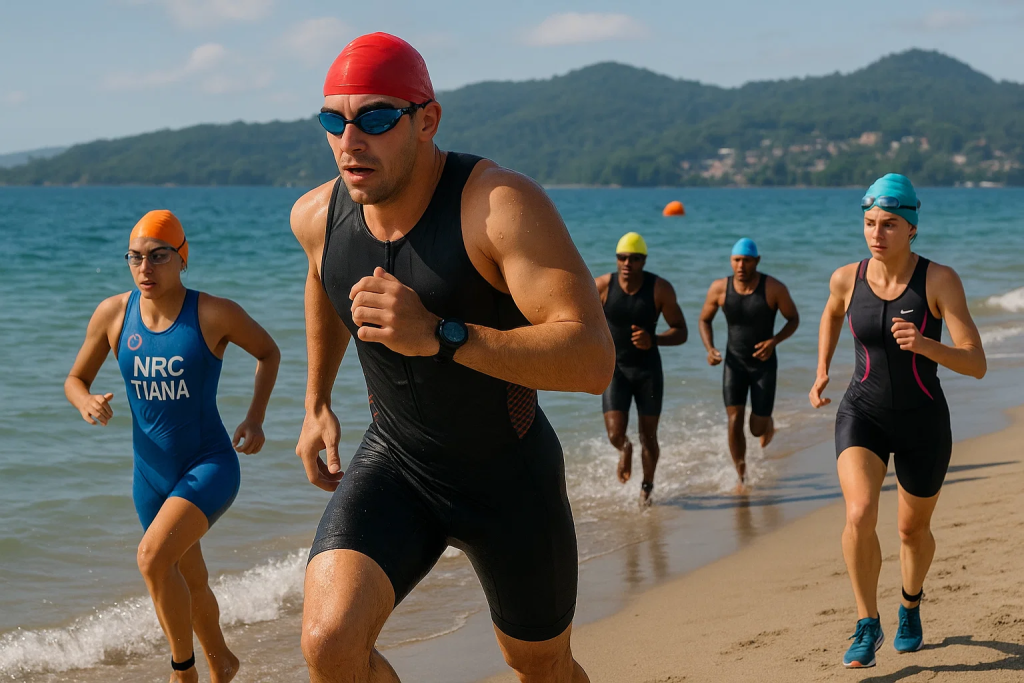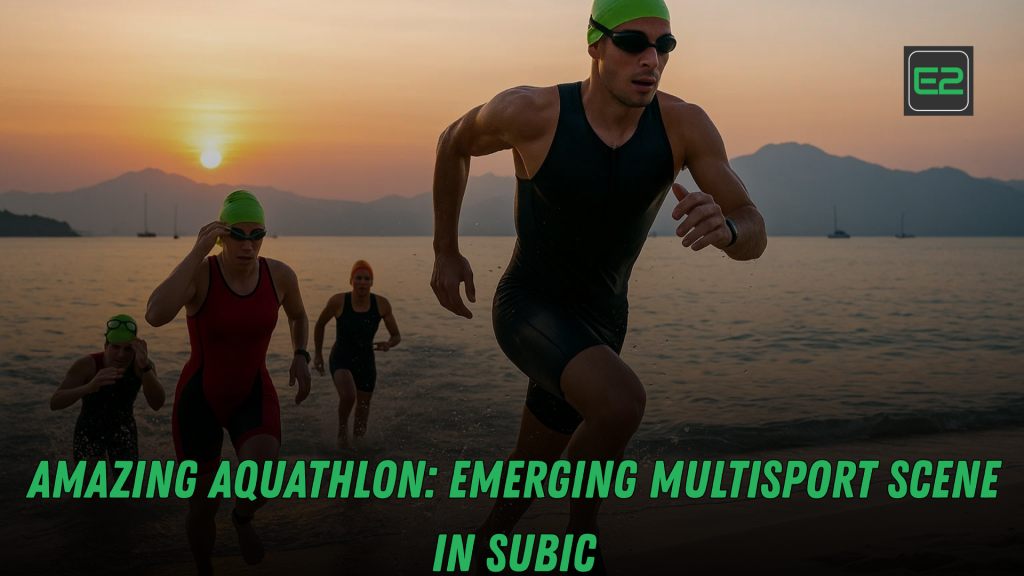Table of Contents
Executive Overview
Aquathlon—swim + run in its purest, transition-light format—is booming in the Philippines, and Subic is quickly becoming a favorite arena. With protected waters, runnable seaside roads, and a supportive multisport culture, Subic offers year-round conditions for beginners, age-groupers, and elite athletes who want the intensity of triathlon without the bike leg. This long-form guide unpacks why Subic works, how to train smarter for the climate and terrain, what gear truly matters, how to optimize race week, and practical checklists to move from “I’m curious” to race-ready—safely and confidently.

What Is Aquathlon—and Why Subic?
Aquathlon is typically a run–swim–run or swim–run format. Distances vary, but common sets are:
- Sprint: 2.5 km run – 1 km swim – 2.5 km run (or 750 m swim + 5 km run)
- Standard: 5 km run – 2 km swim – 5 km run (or 1.5 km swim + 10 km run)
- Youth/novice: shorter distances aligned to age or skill (e.g., 400 m swim + 2 km run)
Why Subic?
- Protected swim: Bays and coves often enjoy milder chop than open coastline—ideal for newer swimmers.
- Runnable routes: Coastal boulevards and inner roads deliver a mix of flats and gentle rollers.
- Logistics: Subic’s tourism infrastructure (lodging, food, services) supports family-friendly race weekends.
- Community: A robust tri/aquathlon culture means access to clinics, group training, and volunteers who “speak multisport.”
Course Archetypes of Aquathlon in Subic (and How to Prep)
While each organizer’s course differs, Subic aquathlons tend to share these archetypal features:
- Coastal Out-and-Back Run
- What you face: Early flats with sun exposure, then light grades.
- How to prep: Practice even pacing on flat loops; learn to drip-feed fluids (small sips) at aid stations; rehearse negative splits.
- Protected Cove/Open-Water Swim
- What you face: Gentle swells, variable sighting; occasional current.
- How to prep: Weekly sighting drills, bilateral breathing, drafting practice with a buddy; exit practice (dolphin dives in light surf if permitted, cautious wading if not).
- Transition on Hard Surface
- What you face: Sand-to-concrete or pontoon-to-road changes; hot ground.
- How to prep: Rehearse quick footwear strategies, rinse basin to remove sand, talc in socks if you use them.
- Heat + Humidity
- What you face: Elevated RPE (perceived effort), higher heart rate, electrolyte loss.
- How to prep: Heat acclimation (10–14 days of progressive warm sessions), electrolyte plan, sun management (cap, sleeves, sunscreen).
Training Foundations: The Aquathlon Pyramid
Think of performance as a pyramid with four levels:
- Technique (swim stroke mechanics, run form, transitions)
- Aerobic capacity (easy-moderate volume, zone-2 discipline)
- Lactate tolerance (threshold sets, bricks)
- Race execution (pacing, nutrition, mental skills)
Swim Essentials
- Form cues: high-elbow catch, stable head, hip-driven rotation, soft kick.
- Three weekly focuses:
- Endurance set (e.g., 4×500 m aerobic)
- Speed/threshold set (e.g., 8×100 m at CSS with 15–20 s rest)
- Skills set (sighting every 6–8 strokes; turns; group starts)
Run Essentials
- Form cues: upright posture, slight forward lean, cadence 170–180 (guide), midfoot contact under center of mass, relaxed shoulders.
- Three weekly focuses:
- Long aerobic run (build connective tissue, economy)
- Intervals (e.g., 6×800 m at 5K pace; or 3×1 mile at 10K pace)
- Brick runs (short run after swim to practice leg feel off the water)
Transition Skills (T0/T1/T2 if run–swim–run)
- Rehearse goggle + cap handling on the move.
- Practice shoe-on/shoe-off and quick drying (microfiber towel + water rinse basin).
- Simulate chaos: train starts with small groups to desensitize.
Two 8-Week Training Plans on Aquathlon(Beginner & Intermediate)
Note: Always consult a medical professional before starting a program. Adjust intensities to your current fitness and heat tolerance.
Plan A — Beginner (finish strong, pain-free)
Weekly structure (6 days, 1 rest):
- Mon: Swim skills 45’ (drills: catch-up, fingertip drag, sighting)
- Tue: Run 35–45’ easy + 6×20’’ strides
- Wed: Swim aerobic 1,600–2,000 m (steady)
- Thu: Brick: Swim 20–30’ easy + Run 15–20’ easy off the water
- Fri: Rest or mobility + light core
- Sat: Run long 55–75’ (zone 2), finish with 5’ brisk
- Sun: Swim speed 1,400–1,800 m (8×100 at CSS + drills)
Progression keys:
- Increase weekly run time by 5–10% max.
- Add sighting to every swim.
- One practice open-water session every two weeks.
Plan B — Intermediate (build speed + race craft)
Weekly structure (7 sessions, 1 rest):
- Mon: Swim threshold 2,000–2,600 m (e.g., 3×400 @ CSS; paddles pull set)
- Tue: Run intervals 45–60’ (e.g., 6×800 @ 5K pace w/ 2’ jog) + drills
- Wed: Swim skills & sprints 1,800–2,200 m (short accelerations, sighting)
- Thu: Brick: OW swim 25–35’ steady → Run 25–35’ progressive (Z2→Z3)
- Fri: Mobility, strength (hips/glutes/core), 30–40’
- Sat: Long run 70–90’ aerobic (last 15’ steady Z3 if heat allows)
- Sun: Swim aerobic 2,000–2,500 m (pull buoy + breathing patterns)
Progression keys:
- Insert race-pace bricks from week 5.
- Practice mass starts, buoy turns, drafting.
- Calibrate heat strategy (see below).
Aquathlon Heat & Humidity Playbook for Subic
Acclimation (10–14 days):
- 4–6 warm sessions/week at easy-moderate intensities; end with brief upticks.
- Hydrate early and often; include electrolytes (sodium is key).
- Post-session cooling: shade, fans, cool towels; carb + protein within 30–60 minutes.
Race-day checklist:
- Sunscreen (broad-spectrum, water-resistant), reapply as allowed.
- Cap/visor & light sleeves to reduce radiant heat.
- Wet the cap pre-run; ice down back of neck if provided at aid station.
- Pacing reality check: Heart rate drifts higher in heat; race by RPE + HR rather than pace alone.
Aquathlon Nutrition & Hydration: Simple, Repeatable, Race-Proven
- Daily: focus on carb-dominant meals around key workouts; lean protein for recovery; electrolytes in tropical climate even on rest days.
- Pre-race evening: familiar dinner (carb + lean protein + low fiber/fat).
- Race morning (2–3 h out): 1–2 g/kg carbs (e.g., toast + banana + sports drink).
- 30–45 min pre-start: small carb top-up (gel or half sports bar) + sips of electrolyte.
- During (sprint/standard):
- Swim: nothing.
- Run: 20–30 g carbs every 20–30 min (gel/chew), 150–250 ml fluid per aid station depending on heat.
- Post-race (0–60 min): carb + protein (3:1 to 4:1), 600–900 ml fluids with electrolytes, light salty snack.

Aquathlon Gear Guide: What You Truly Need (No Gimmicks)
Swim:
- Goggles (tinted or photochromic), backup pair.
- Swim cap (race-issued + one spare).
- Optional: sleeveless tri top for comfort; anti-chafe balm (neck, underarms).
Run/Transition:
- Lightweight running shoes with drainage.
- Elastic laces; race belt (if bib required).
- Microfiber towel basin (small collapsible tub if organizer allows at rack).
- Cap/visor, sunglasses, breathable top.
- Sunscreen, anti-chafe, small reusable flask (check rules).
Safety add-ons for training:
- Visibility buoy for OW practice (not used in race unless allowed).
- Whistle; bright swim cap; training buddy protocol.
Aquathlon Transition Mastery: Speed Without Rush
- Visualize the flow. Lay gear in order of operations: towel → shoes → cap/visor → belt/flask.
- Two-touch rule. Each item touched once to place, once to wear.
- Sand solution. Quick foot rinse + towel stomp; talc in socks if you wear them.
- Practice exits. Swim until fingertips scrape bottom, then stand and run—don’t waste time walking too early.
Safety & Etiquette in Aquathlon
- Pre-race honesty: Seed yourself by realistic swim time; reduce contact at start.
- Sighting discipline: Every 6–8 strokes; breathe bilateral if chop favors one side.
- Passing on the run: Announce “On your left”; avoid clipping heels.
- Aid station etiquette: Eye contact, grab, move; don’t stop dead on the line.
- Medical pull-out: If dizzy or cramping badly, step off, ask for assistance—finish lines can wait; health cannot.
Travel & Logistics Tips (Family-Friendly Weekend)
- Arrive early (D-2). Shake-out swim/run; register; breathe in the venue.
- Scout the course. Note buoy angles, sun direction, aid locations, shaded areas.
- Book close. Stay near start to minimize race-morning transport.
- Plan meals. Familiar carb sources; pack portable snacks for kids/support crew.
- Make it a vacation. Non-race hours: beach walks, easy sightseeing, cafés—keep legs fresh but spirits high.
Race-Week Timeline (D-7 to Race Day)
- D-7: Last quality swim & run intervals; confirm gear, lodging, transport.
- D-5: OW skills + short brick; finalize nutrition list; trim toenails (avoid race-week blisters).
- D-3: Volume dips; sharpen with 6×100 m swim accelerations, 4×20’’ run strides.
- D-2: Arrive on site; pick up kit; 15–20’ easy swim with 4×30’’ pick-ups; course recon.
- D-1: 15’ easy jog + 6 strides; 10’ easy swim; early dinner; lay out gear; sleep.
- Race morning: Eat 2–3 h out; sip electrolyte; warm up (5–10’ jog + drills; 3–5’ swim if allowed); breathe.
Aquathlon Pacing & Strategy (By Format)
Run–Swim–Run:
- Run 1: Hold back—smooth Z3, not a 5K PB.
- Swim: Settle in first 100–200 m; find feet to draft; steady turns.
- Run 2: Build; last 1–2 km empty the tank.
Swim–Run:
- Swim start: Position wide if contact stresses you; breathe long early.
- Run: First km steady; build after aid station; strong cadence under fatigue.
Common Mistakes (and Easy Fixes)
- Starting too fast on Run 1: Fix: lock RPE at “controlled discomfort,” not panic pace.
- Poor sighting: Fix: drill sighting every set; learn to lift eyes minimal height.
- Overheating: Fix: cap, sleeves, wet head, ice at aid, back off 10–15 s/km if HR spikes.
- New gear on race day: Fix: nothing new—test everything twice in training.
Community: How to Plug Into Subic’s Multisport Scene
- Find a local club: Group swims with kayaks/boards; weekend bricks; car-share to venues.
- Join clinics: Coaches often run open-water and transition sessions pre-event.
- Volunteer: If you’re not racing, marshal or aid-station—you’ll learn race flow and make friends.
Environmental Respect in Aquathlon
- Leave no trace: Pack out gels, cups (follow organizer’s rules), and tape.
- Wildlife awareness: No touching or harassing marine life; stick to swim lanes.
- Community courtesy: Thank volunteers, share roads, respect local residents.
Strong Call-to-Action
Ready to step into Subic’s aquathlon scene?
- Beginners: Pick a sprint distance 8–10 weeks out. Start Plan A today, do one open-water session every two weeks, and recruit a training buddy.
- Intermediates: Choose a standard distance 10–12 weeks out. Follow Plan B, add heat acclimation, and schedule two race-simulation bricks.
- Clubs & coaches: Host a free skills clinic (sighting + transitions). Film 60-second tips and share them weekly to grow the sport.
- Families: Make it a Subic weekend—support at the race, then celebrate on the beach. A healthy tradition starts with one start line.
If you want a printable Race-Week Checklist + Nutrition Timing Card, say “SEND AQUATHLON PACK” and include your distance (Sprint/Standard).
Final Word
Aquathlon in Subic isn’t just a race—it’s a gateway to multisport: simple, streamlined, and still plenty challenging. With an 8-week plan, smart heat strategy, minimal gear, and a strong sense of community, you’ll step onto the start line with real confidence. See you in those calm bays and along the coastal roads—where you’ll swim, run, and belong.
Aquathlon—swim plus run in a streamlined format—has found an ideal home in Subic, thanks to its protected waters, runnable coastal roads, and a welcoming multisport community. The venue suits beginners who want triathlon intensity without the bike, age-groupers chasing PRs, and families looking for a destination race weekend with reliable logistics, lodging, and dining.

Why Subic works: Most swims are held in sheltered bays with milder chop than open seas, making open-water skills easier to learn. Run courses typically follow coastal out-and-backs—fast but sun-exposed—so even pacing, hydration discipline, and sun management are vital. Transitions often move from sand or pontoons onto hot hard surfaces, so foot care and quick setup matter.
Formats & pacing: Common distances include Sprint (e.g., 750 m swim + 5 km run or 2.5–1–2.5) and Standard (e.g., 1.5 km swim + 10 km run or 5–2–5). For run–swim–run, hold back on Run 1, settle quickly in the water, then build through the final run. For swim–run, start the swim wide to avoid contact and lift cadence gradually during the first kilometer of the run.
Training foundations: Success rests on four layers—technique, aerobic base, lactate tolerance, and race execution. Swimming cues include a high-elbow catch, stable head, hip-driven rotation, and bilateral breathing; running cues include upright posture, slight forward lean, midfoot contact, and relaxed shoulders. Weekly structure typically blends an endurance swim, a threshold/speed swim, skills (sighting, buoy turns, group starts), a long aerobic run, intervals, and brick runs off the water. Two 8-week plans—Beginner (finish strong, pain-free) and Intermediate (add speed and craft)—rotate these elements while building heat tolerance and transition fluency.
Heat & humidity strategy: In the 10–14 days before race day, include warm-weather sessions at easy-moderate intensity to acclimate. On race day, use broad-spectrum sunscreen, a cap/visor, and consider light sleeves. Expect higher heart rate and RPE; guide effort by RPE + HR, not pace alone. Cool with water and ice when available.
Nutrition & hydration: Emphasize electrolytes—especially sodium—for fluid balance, plus carbohydrates for energy. Race morning, eat a familiar, carb-dominant breakfast 2–3 hours pre-start and top up 30–45 minutes out. During the run, aim for 20–30 g carbs every 20–30 minutes and sip 150–250 ml at aid stations, adjusted for heat. Recover within 60 minutes with carbs + protein.
Gear essentials (no gimmicks): Tinted or photochromic goggles, a spare; a comfortable cap; lightweight running shoes with elastic laces; race belt, microfiber towel, sunglasses, anti-chafe, and (if allowed) a small handheld flask. For training, a bright swim cap, a visibility buoy, and a buddy protocol enhance safety.
Transitions: Lay gear in order of operations, follow a two-touch rule for each item, include a quick foot-rinse to remove sand, and practice standing only when your fingertips brush bottom to avoid walking too early.
Logistics & community: Arrive D-2 to pick up your kit, do a short shake-out swim/run, and recon the course. Subic’s clubs, clinics, and volunteers make it easy to find group sessions, improve skills, or even volunteer when you’re not racing.
Bottom line & CTA: Subic aquathlon is a gateway to multisport—simple, challenging, and community-driven. Beginners should target a Sprint 8–10 weeks out and follow a basic plan; intermediates can step to Standard with heat acclimation and race-simulation bricks. Commit to responsible pacing, hydration, and respect for the environment—and you’ll arrive at the start line calm, prepared, and confident.
Frequently Asked Questions (FAQ)
1) Which distance should I choose as a beginner?
Pick the Sprint (e.g., 750 m swim + 5 km run) and give yourself 8–10 weeks to build technique, endurance, and open-water confidence. Once you can finish a sprint comfortably, consider stepping up to Standard.
2) I’m a weak swimmer—Is Subic suitable for me?
Yes. Most Subic swims take place in protected waters rather than fully open sea. That said, you should still practice sighting, bilateral breathing, and join a group open-water session with safety support (kayak/SUP) before race day.
3) What do I need for transitions?
Keep it minimal: lightweight running shoes with elastic laces, a cap/visor and sunglasses for the run, a quick-dry microfiber towel, and a race belt. In hot weather, a small handheld flask can help—if allowed by the race rules.
4) What nutrition matters most in hot, humid conditions?
Prioritize electrolytes (especially sodium) to maintain fluid balance, plus carbohydrates for energy. Hydrate with water + electrolytes before and during the run; within 60 minutes of finishing, take in carbs + protein for recovery.
5) How early should I arrive in Subic before the race?
Ideally D-2 (two days before). That gives you time to pick up your kit, do a light shake-out swim/run, and recon the swim and run courses. Arriving early also helps you sleep well and handle any last-minute issues calmly.
